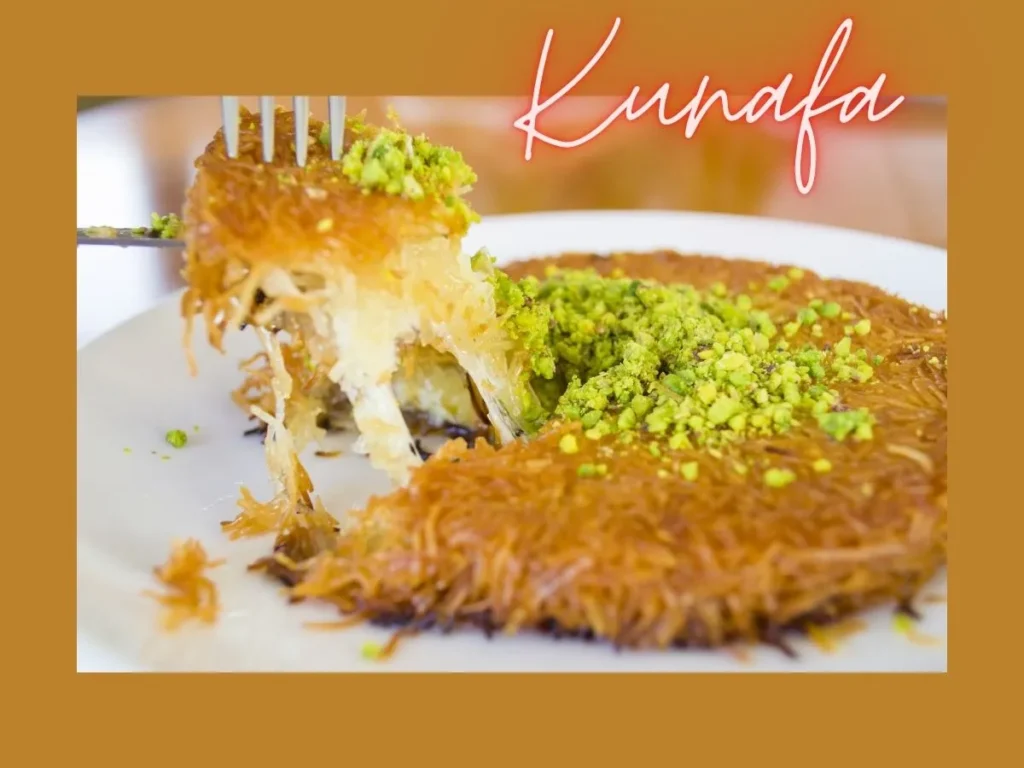Table of Contents
ToggleKunafa: The Delicious History of a Middle Eastern Dessert
Kunafa, a delightful and iconic dessert, holds a special place in the hearts of many across the Middle East and Mediterranean regions. Known for its crispy, cheese-filled layers drenched in sweet syrup, Kunafa is a staple in celebrations and festive occasions. This rich, decadent treat has a storied past that reflects the cultural tapestry of the regions it hails from. Let’s delve into the fascinating origins of Kunafa and trace its journey through history.
Kunafa is a delicious Middle Eastern dessert made with shredded phyllo dough, a sweet cheese filling, and a variety of toppings. It is a popular dessert during the month of Ramadan, and is also enjoyed throughout the year.
There are many different variations of kunafa, but the most common is made with a cheese filling made from a mixture of mozzarella, ricotta, and cream cheese. The cheese is then layered with the shredded phyllo dough, and the entire dish is baked until the dough is golden brown and the cheese is melted and gooey.

Ancient Roots
The history of Kunafa is intertwined with the culinary traditions of the Middle East, with its origins believed to date back to the 10th century. It is widely accepted that Kunafa was first made in the Levant region, which includes modern-day Lebanon, Syria, Jordan, and Palestine. The earliest known references to Kunafa come from the city of Nablus in Palestine, where it was known as “Knafeh Nabulsiyeh.”
Culinary Influences
The name “Kunafa” itself is derived from the Arabic word “Kanaf,” which means to shelter or protect. This could be a nod to the way the dessert envelops its filling, typically cheese, in a protective layer of dough. There are several variations of Kunafa, and each region has its unique take on the dish. The dough used can be either kataifi (shredded phyllo dough) or semolina-based, depending on local customs and preferences.
The Nablus Connection
Nablus, a city in the West Bank, is often considered the birthplace of Kunafa. The Nabulsi variant of Kunafa is particularly famous for its use of a special cheese called Nabulsi cheese, which has a distinct salty flavor that perfectly balances the sweetness of the syrup. This version is typically made with a base of semolina dough, layered with cheese, and topped with more semolina before being baked to golden perfection and soaked in sugar syrup.

Spread and Evolution
As with many dishes, Kunafa’s journey didn’t stop at its point of origin. It spread across the Ottoman Empire, which played a significant role in introducing the dish to various regions. The Ottoman influence extended Kunafa’s reach to places like Egypt, Turkey, and Greece, where the dessert evolved to incorporate local ingredients and culinary techniques.
Variations Across Regions
Turkey:
In Turkey, Kunafa is known as “Künefe.” Turkish Kunafa is typically made with a stretchy, unsalted cheese like mozzarella or Hatay cheese and is cooked in small, individual-sized portions. It is often served with clotted cream or pistachios.
Egypt:
Egyptian Kunafa is often made with a base of vermicelli-like dough that is layered with a mixture of nuts, sweetened cream, or even mangoes. The Egyptian variation is more versatile and includes a wide array of fillings.
Greece:
Known as “Kanafeh” in Greece, the dessert is made with a combination of kataifi dough and a filling of nuts, typically walnuts or almonds. It is often flavored with cinnamon and cloves, giving it a distinct, aromatic profile.
Kunafa in Modern Times
Today, Kunafa remains a beloved dessert in many countries. Its popularity has even transcended borders, with Middle Eastern bakeries and restaurants introducing Kunafa to a global audience. Modern twists on the traditional recipe include variations with chocolate, fruits, and different types of cheese, catering to contemporary palates while still honoring the dish’s rich heritage.
Conclusion
Kunafa’s journey from its ancient roots in the Levant to becoming a global delicacy is a testament to the dish’s universal appeal and the cultural exchanges that shape our culinary traditions. Whether enjoyed in its traditional form or with modern adaptations, Kunafa continues to be a symbol of hospitality, celebration, and the shared joy of good food.
Video Credit: YouTube & Kebeb Baba